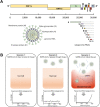Depicting SARS-CoV-2 faecal viral activity in association with gut microbiota composition in patients with COVID-19
- PMID: 32690600
- PMCID: PMC7385744
- DOI: 10.1136/gutjnl-2020-322294
Depicting SARS-CoV-2 faecal viral activity in association with gut microbiota composition in patients with COVID-19
Abstract
Objective: Although severe acute respiratory syndrome coronavirus 2 (SARS-CoV-2) RNA was detected in faeces of patients with COVID-19, the activity and infectivity of the virus in the GI tract during disease course is largely unknown. We investigated temporal transcriptional activity of SARS-CoV-2 and its association with longitudinal faecal microbiome alterations in patients with COVID-19.
Design: We performed RNA shotgun metagenomics sequencing on serial faecal viral extractions from 15 hospitalised patients with COVID-19. Sequencing coverage of the SARS-CoV-2 genome was quantified. We assessed faecal microbiome composition and microbiome functionality in association with signatures of faecal SARS-CoV-2 infectivity.
Results: Seven (46.7%) of 15 patients with COVID-19 had stool positivity for SARS-CoV-2 by viral RNA metagenomic sequencing. Even in the absence of GI manifestations, all seven patients showed strikingly higher coverage (p=0.0261) and density (p=0.0094) of the 3' vs 5' end of SARS-CoV-2 genome in their faecal viral metagenome profile. Faecal viral metagenome of three patients continued to display active viral infection signature (higher 3' vs 5' end coverage) up to 6 days after clearance of SARS-CoV-2 from respiratory samples. Faecal samples with signature of high SARS-CoV-2 infectivity had higher abundances of bacterial species Collinsella aerofaciens, Collinsella tanakaei, Streptococcus infantis, Morganella morganii, and higher functional capacity for nucleotide de novo biosynthesis, amino acid biosynthesis and glycolysis, whereas faecal samples with signature of low-to-none SARS-CoV-2 infectivity had higher abundances of short-chain fatty acid producing bacteria, Parabacteroides merdae, Bacteroides stercoris, Alistipes onderdonkii and Lachnospiraceae bacterium 1_1_57FAA.
Conclusion: This pilot study provides evidence for active and prolonged 'quiescent' GI infection even in the absence of GI manifestations and after recovery from respiratory infection of SARS-CoV-2. Gut microbiota of patients with active SARS-CoV-2 GI infection was characterised by enrichment of opportunistic pathogens, loss of salutary bacteria and increased functional capacity for nucleotide and amino acid biosynthesis and carbohydrate metabolism.
Keywords: diagnostic virology; gut inflammation; infectious disease.
© Author(s) (or their employer(s)) 2021. Re-use permitted under CC BY-NC. No commercial re-use. See rights and permissions. Published by BMJ.
Conflict of interest statement
Competing interests: None declared.
Figures





Comment in
-
Residual SARS-CoV-2 viral antigens detected in GI and hepatic tissues from five recovered patients with COVID-19.Gut. 2022 Jan;71(1):226-229. doi: 10.1136/gutjnl-2021-324280. Epub 2021 Jun 2. Gut. 2022. PMID: 34083386 No abstract available.
References
Publication types
MeSH terms
LinkOut - more resources
Full Text Sources
Other Literature Sources
Medical
Miscellaneous
